
Solvents
Solvents are liquids in which other solids or liquid substances can be dissolved, that is to say break up in molecular terms without the chemical composition of the dissolved substances changing. Solvents are used, for example, to make solid binders liquid, to thin liquid binders and to clean materials. Solvents evaporate if they are exposed to air. The most well-known solvents for artists are water, white spirit and turpentine.
White spirit and turpentine
In order to avoid any confusion it should be noted that turpentine used by artists is actually called turpentine oil. Turpentine is the original balsam that is tapped from various pine-trees and from which the volatile turpentine oil is acquired through distillation. In chemical terms turpentine oil consists of various "terpenes" and due to its good properties as a solvent it is highly suited as a solvent for (oil) paints, mediums and varnishes. By distilling the turpentine oil once more the level of resin-like substances is reduced to a minimum and the practically 100% volatile "rectified turpentine" is produced. Serious artists are strongly advised to use only this quality.
White spirit, as is petrol, is a petroleum distillate. The odour and capacity to act as solvent depend on the extent to which the so-called "aromatic hydrocarbons" are present in the solvent. Well-known aromatic hydrocarbons are xylene and toluene, which incidentally are present only in small quantities in white spirit. Various types of white spirit are available. In general the solvent capacity increases if the percentage of aromatic hydrocarbons is higher. The odourless property of odourless white spirit is the result of the almost complete lack of aromatic hydrocarbons, resulting in not only the odour being much less but the solvent capacity as well. Talens "Artists' grade" white spirit and Odourless white spirit are 100% volatile.
In general turpentine oil has a larger solvent capacity than white spirit. Dammar resin does for example dissolve in turpentine oil but not in white spirit. Due to its low solvent capacity odourless white spirit is not suitable for removing old varnish layers.
Although it is often thought that things that come directly from nature are less harmful than those produced chemically, it should be emphasised here that turpentine oil is more harmful than white spirit, more irritable for the eyes and skin and is more likely to lead to oversensitivity (allergic reactions). In theory, both thinners can be used both to thin the paint and to clean the brushes. However, in connection with the evaporation and the associated contamination of the air, it is recommended that white spirit be used for cleaning materials. The resin-like odour of turpentine is considered by many painters as pleasant and is usually used as an argument for using turpentine as thinner for the paint.Ensure at all times that the work room is well ventilated.